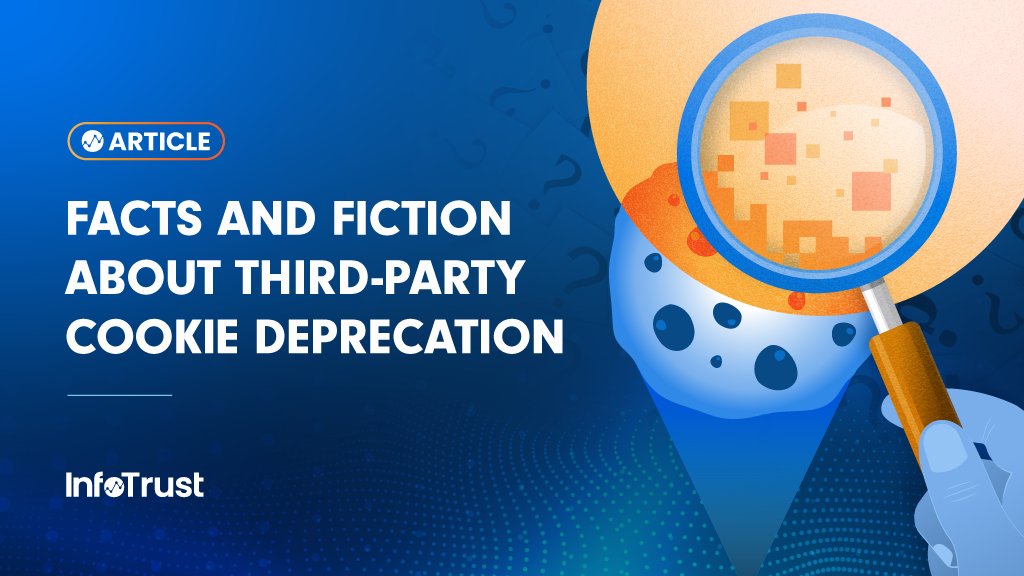With third-party cookie deprecation in Chrome just around the corner (now set for the start of 2025), organizations understandably have many questions and misconceptions about what it means for them. A lot is changing! But many new solutions are also coming online to address advertising and analytics use cases traditionally reliant upon third-party cookies. Let’s review some commonly held beliefs to set the record straight on facts and fiction.
Third-party cookie deprecation is happening.
[Fact]
While Google Chrome has delayed deprecation for now a third time to early 2025, it is still happening (we promise)! It is also important for organizations to keep in mind that third-party cookie support has already been deprecated in both Firefox and Safari. Apple’s ITP initiative (which deprecated support for third-party cookies back in 2019) also applies to any browser running in iOS. Globally, Google Chrome has the highest browser share at approximately 65 percent of web users, but for some organizations in the United States and EU, the majority of traffic is already “cookieless”.
There’s nothing I can do today for preparation.
[Fiction]
There are ample things that you can do today to prepare! Begin with a strategic risk assessment to identify which of your current activities and solutions are reliant upon third-party cookies. From there, prioritize based upon reliance for the strategies and tactics to address. Once these are identified, you can begin exploring alternatives and testing various methods to achieve desired business outcomes by alternative cookieless means.
Too many organizations are taking the approach of “my adtech will take care of it”. Yes, the platforms you are using are incorporating new signals and introducing new functionality, but that is not enough. You must understand your desired outcomes and risks to effectively adjust your strategies. If you aren’t, others are. Those who do will be the ones to achieve competitive advantage once the dust settles.
Third-party tags are going away.
[Fiction]
A common statement we hear from marketers all too often is, “how are we going to continue to collect data on our website if third-party cookies are gone?” Cookies are different from tags!
Tags are the image pixels or javascript, which run on a page and are responsible for data collection, as well as the setting and accessing of cookies in the browser.
Cookies are small text files that store information for later reference in the browser. First-party cookies are set on the domain of the website being accessed and only accessible from that domain. Third-party cookies are set on a third-party domain and accessible from domains outside just the domain of the website being accessed.
Third-party cookie deprecation is the deprecation of support for third-party cookies to limit cross-site tracking of users. First-party cookies are not going away, nor are third-party tags. Data collection on owned domains is not impacted, nor is the ability to associate consumer behavior within an owned domain across pages or site visits.
Third-party cookie deprecation doesn’t impact me until Google Chrome removes support.
[Fiction]
Globally, Google Chrome’s market share is approximately 65 percent (as of this writing). Both Safari and Firefox (21 percent market share) have already deprecated support for third-party cookies. Further, any browser on iOS does not have third-party cookie support due to Apple’s ITP restrictions. For many organizations, this means that most of their user base already doesn’t support third-party cookies. The cookieless future is no longer the future—it is now.
There are alternative solutions to third-party cookies for advertising use cases.
[Fact]
Yes, adtech has traditionally been built upon third-party cookies to enable use cases such as personalized targeting, attribution, and impression capping, but as the regulatory and technical landscape has shifted over the past five years, platforms have been accelerating their introduction of “cookieless” solutions.
To start, Google Chrome is introducing new browser APIs as part of their Privacy Sandbox initiative, which are purpose-built solutions for common use cases traditionally reliant upon third-party cookies. These include the Protected Audiences API for retargeting, Topics for interest-based targeting, and the Attribution Reporting API for measurement. Adtech platforms are building out support for these APIs within their products.
Also, the past few years have witnessed the introduction of alternative IDs such as ID2.0, ID5, and RampIDs, which can facilitate the identification of consenting consumers who have provided a persistent identifier across different domains and thus enable targeting and measurement at the user level. Solutions around these identifiers are being built into many adtech platforms.
Finally, the rise of machine learning and AI has allowed platforms to introduce functionality to model consumer behavior, power measurement, and targeting solutions.
The combination of all of these factors resulted in the introduction of numerous solutions to solve advertising use cases in the absence of third-party cookies. Testing of these solutions is still in its early stages, but some organizations are already reporting increases in effectiveness as a result of migrating media spend to cookieless solutions.
My adtech platforms will take care of anything I need to do.
[Fiction]
Adtech platforms are actively building out new functionality to address common use cases that traditionally have relied upon third-party cookies. But there is no silver bullet. It is critical for organizations to understand their desired outcomes, characteristics of their consumer base, and approaches available to execute their strategies.
Different platforms are approaching cookieless solutions in different ways. For example, Google Marketing Platforms are focusing more on user-provided data, modeling, AI, and the inclusion of signals from Privacy Sandbox APIs to build out new solutions. Alternatively, The Trade Desk is focusing more on Alternative IDs and functionality built around identifiable users. The ideal solutions for advertisers will depend upon several factors related to their consumer base and strategic outcomes. Broader advertising strategies may also need to be adjusted to ensure success in a more privacy-centric environment.
Privacy means there can be less reliance upon third-party technology. More reliance must be placed upon advertiser-owned data and a strategy built to best utilize this data. Adtech can support various tactics, but it can not be relied upon to address all challenges stemming from third-party cookie deprecation.
Measurement and attribution will change.
[Fact]
Gone are the days of ubiquitous one-to-one deterministic user measurement. Not all consumers will consent to the collection and processing of their behavioral data, and not all consumers will provide persistent identifiers, which can be used to tie together behaviors across domains for attribution. Both of these facts result in gaps in visibility along the consumer journey.
Privacy-centric measurement and attribution solutions will focus more on aggregate-level reporting (both for campaigns and cohorts), as well as rely on modeling using the data from consenting identifiable users along with anonymous interaction data to fill gaps. This shift requires advertisers to change how they approach measurement as well as the data collection architectures used to facilitate optimization.
I will still be able to personalize advertising to my consumers.
[Fact]
Personalization is still possible (and demanded by consumers)! The ways in which personalization is accomplished just changes. New browser technology like Chrome’s Privacy Sandbox can facilitate personalized advertising, both retargeting and interest-based targeting, for a subset of your consumers. Alternative IDs can further enable personalization for consenting and identifiable users. Further, solutions like publisher-provided audiences, audiences from retail media networks, and highly advanced contextual targeting also facilitate personalized messaging to your ideal consumers in the absence of third-party cookies.
Deprecation of user identifiers will continue beyond third-party cookies.
[Fact]
Technology providers introduce restrictions to protect consumer privacy; Adtech finds alternatives; technology providers close the gaps; and around and around the cycle goes. In response to third-party cookie deprecation, multiple platforms are shifting to IP addresses for targeting and measurement use cases, while still others are relying upon Alternative IDs.
Chrome already has a future Privacy Sandbox proposal for IP Protection, essentially using a proxy by default for all web traffic, likely to be adopted in the next several years. Apple continues to introduce updates to their ITP initiative to close work-arounds for cross-domain identification, as well as introduce Hide My Email, which significantly limits the ability for Alternative IDs to be effective for users using the feature.
All of this underscores the fact that the industry is changing. Consumers demand privacy, and technology providers must give them what they want. Advertisers must accept this new reality and not jump from technical work-around to technical work-around but instead shift their strategy to true privacy-centric principles and solutions that respect consumer privacy while still delivering results.
There will be a “silver bullet” available to replace third-party cookies.
[Fiction]
There is no single solution! The impetus for third-party cookie deprecation is an increase in consumer expectations related to the privacy and protection of their personal data. All solutions moving forward must respect this. Gone are the days of ubiquitous, deterministic consumer surveillance. Advertisers must shift their strategies to focus more on deriving value from consented consumer data and aggregate data sets. Those that accept and adapt will survive the third-party cookie apocalypse.
Third-party cookies will soon be a thing of the past. New solutions are coming online to help advertisers address use cases such as personalized targeting and measurement. Strategies must change. It is important for organizations to internalize these facts and set the course accordingly. Organizations that best assess their current state, chart their path forward, and test new solutions to find their ideal fit will realize competitive advantage.



